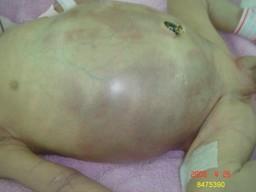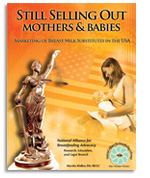What is the WHO-CODE?
The primary purpose of the “WHO-CODE” is to protect mothers and babies from the highly effective, aggressive and predatory marketing of substitutes for breastfeeding (i.e. infant formula, bottles, artificial nipples) at the most vulnerable period of their lives, the birth of a new baby.

Health workers helping vulnerable new moms and babies, day after day, have discovered an alarming trend: in areas where formula and bottles are marketed heavily, breastfeeding rates go down, and infection, disease and mortality go up. This happens in countries around the globe, independent of a country’s economic status. In fact, it is estimated that globally, at least 1.5 million babies’ lives could be saved every year from improved breastfeeding & complementary feeding; in the U.S., it is estimated that 900 babies’ lives could be saved every year from improved breastfeeding rates, and $13 billion could be saved in health care and associated costs for ten pediatric diseases alone.
Some people don’t believe that formula marketing affects a mother’s decision to try breastfeeding or her ability to continue. It’s understandable: it is human nature not to want to believe that we can be so easily duped out of protecting and advancing our own and our babies’ health! So, before you read further, we urge you to please read this article on the 10 Most Successful Ad Campaigns of All Time. Read about what ad campaign helped Miller go from selling 7 million to 31 million barrels of beer, which ad increased Clairol’s sales 800%, and how Nike’s market share jumped from 18% to 43%. Now consider that in 2004, just as the U.S. government was rolling out its largest effort, the three-year, $40 million “Babies Were Born to Be Breastfed” awareness campaign, formula advertising almost doubled to $50 million annually. More importantly, the government’s campaign was diluted and rendered ineffective under the influence of industry lobbyists. Further, under lobbying pressure, a valuable, national meta-study conclusively showing the association of breastfeeding and lower rates of disease was suppressed. No surprise: Breastfeeding rates went down. Breastfeeding was outmarketed, and this is precisely why examples of successful formula marketing make it into marketing textbooks. Try to remain objective while watching this extremely sophisticated formula commercial, and then consider it in the context of research showing that breastfeeding protects against SIDS and is critical in the NICU.
In recognition of the devastating effect of formula and bottle marketing, the World Health Organization and Unicef adopted the “WHO-CODE” in 1981. The “WHO-CODE” is short for the World Health Organization’s International Code of the Marketing of Breastmilk Substitutes. Scores of countries have enacted legislation implementing all or many of the provisions of the Code, but the U.S. has not. Because “The Code” is a voluntary pledge, it is easy for countries to say they uphold the code even when they don’t enforce the following stipulations:
 We love to claim we are savvier at looking past the claims of a print ad or commercial–even when studies show us that rates of breastfeeding decline when formula advertising increases–but it is undeniable that we are easily influenced and persuaded by our trusted doctors, family members, and peers. Formula companies are turning respected authorities, i.e. health professionals and organizations, into marketing arms for their product, a practice which is extremely unethical, and is especially hard for the public to see through. Marsha Walker of NABA has collected examples of formula companies sponsoring pediatrician conferences, donating to nursing professional associations, and providing “information” and gift bags to Ob/Gyns for their patients.
We love to claim we are savvier at looking past the claims of a print ad or commercial–even when studies show us that rates of breastfeeding decline when formula advertising increases–but it is undeniable that we are easily influenced and persuaded by our trusted doctors, family members, and peers. Formula companies are turning respected authorities, i.e. health professionals and organizations, into marketing arms for their product, a practice which is extremely unethical, and is especially hard for the public to see through. Marsha Walker of NABA has collected examples of formula companies sponsoring pediatrician conferences, donating to nursing professional associations, and providing “information” and gift bags to Ob/Gyns for their patients.
We’ve learned that formula companies donate to hospital NICUs–a terribly mixed message

Formula-fed babies are at greater risk for Necrotizing Enterocolitis, a painful, often fatal, and expensive to treat disease.
Health workers helping vulnerable new moms and babies, day after day, have discovered an alarming trend: in areas where formula and bottles are marketed heavily, breastfeeding rates go down, and infection, disease and mortality go up. This happens in countries around the globe, independent of a country’s economic status. In fact, it is estimated that globally, at least 1.5 million babies’ lives could be saved every year from improved breastfeeding & complementary feeding; in the U.S., it is estimated that 900 babies’ lives could be saved every year from improved breastfeeding rates, and $13 billion could be saved in health care and associated costs for ten pediatric diseases alone.
Some people don’t believe that formula marketing affects a mother’s decision to try breastfeeding or her ability to continue. It’s understandable: it is human nature not to want to believe that we can be so easily duped out of protecting and advancing our own and our babies’ health! So, before you read further, we urge you to please read this article on the 10 Most Successful Ad Campaigns of All Time. Read about what ad campaign helped Miller go from selling 7 million to 31 million barrels of beer, which ad increased Clairol’s sales 800%, and how Nike’s market share jumped from 18% to 43%. Now consider that in 2004, just as the U.S. government was rolling out its largest effort, the three-year, $40 million “Babies Were Born to Be Breastfed” awareness campaign, formula advertising almost doubled to $50 million annually. More importantly, the government’s campaign was diluted and rendered ineffective under the influence of industry lobbyists. Further, under lobbying pressure, a valuable, national meta-study conclusively showing the association of breastfeeding and lower rates of disease was suppressed. No surprise: Breastfeeding rates went down. Breastfeeding was outmarketed, and this is precisely why examples of successful formula marketing make it into marketing textbooks. Try to remain objective while watching this extremely sophisticated formula commercial, and then consider it in the context of research showing that breastfeeding protects against SIDS and is critical in the NICU.
In recognition of the devastating effect of formula and bottle marketing, the World Health Organization and Unicef adopted the “WHO-CODE” in 1981. The “WHO-CODE” is short for the World Health Organization’s International Code of the Marketing of Breastmilk Substitutes. Scores of countries have enacted legislation implementing all or many of the provisions of the Code, but the U.S. has not. Because “The Code” is a voluntary pledge, it is easy for countries to say they uphold the code even when they don’t enforce the following stipulations:
- No advertising of breast milk substitutes to families. (Read: Why formula advertising is different from other types of advertising, making it predatory.)
- No free samples or supplies in the health care system.
- No promotion of products through health care facilities, including no free or low-cost formula.
- No contact between marketing personnel and mothers.
- No gifts or personal samples to health workers.
- No words or pictures idealizing artificial feeding, including pictures of infants, on the labels or the product.
- Information to health workers should be scientific and factual only.
- All information on artificial feeding, including labels, should explain the benefits of breastfeeding and the costs and hazards associated with artificial feeding.
- Unsuitable products should not be promoted for babies.
- All products should be of high quality and take account of the climate and storage conditions of the country where they are used.
 We love to claim we are savvier at looking past the claims of a print ad or commercial–even when studies show us that rates of breastfeeding decline when formula advertising increases–but it is undeniable that we are easily influenced and persuaded by our trusted doctors, family members, and peers. Formula companies are turning respected authorities, i.e. health professionals and organizations, into marketing arms for their product, a practice which is extremely unethical, and is especially hard for the public to see through. Marsha Walker of NABA has collected examples of formula companies sponsoring pediatrician conferences, donating to nursing professional associations, and providing “information” and gift bags to Ob/Gyns for their patients.
We love to claim we are savvier at looking past the claims of a print ad or commercial–even when studies show us that rates of breastfeeding decline when formula advertising increases–but it is undeniable that we are easily influenced and persuaded by our trusted doctors, family members, and peers. Formula companies are turning respected authorities, i.e. health professionals and organizations, into marketing arms for their product, a practice which is extremely unethical, and is especially hard for the public to see through. Marsha Walker of NABA has collected examples of formula companies sponsoring pediatrician conferences, donating to nursing professional associations, and providing “information” and gift bags to Ob/Gyns for their patients.We’ve learned that formula companies donate to hospital NICUs–a terribly mixed message


No comments:
Post a Comment